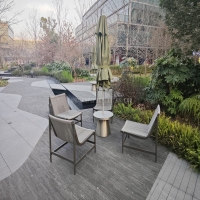Welcome to the website for landscape facilities products and knowledge.
How does the table’s design account for the need for visual focus in presentation settings?
In professional presentation environments, every element of design serves a purpose—none more critical than the table itself. Modern presentation tables are engineered not merely as surfaces for notes or laptops but as strategic tools for directing visual attention. Unlike conventional rectangular tables that create physical and psychological barriers between presenter and audience, contemporary designs often feature subtle angles, tapered profiles, and carefully calculated heights.
The primary consideration is sightline management. A well-designed presentation table maintains clear, unobstructed views between speaker and audience members. This is achieved through several intentional design choices: lower profiles that don't impede vision, transparent elements in certain sections, and strategic positioning of structural supports. The table becomes an invisible facilitator rather than a visual obstacle.
Material selection further enhances visual focus. Matte finishes reduce glare and reflection that might distract from the presenter. Neutral color palettes ensure the table doesn't compete for attention, while subtle textures add professional sophistication without visual noise. The table's visual weight is carefully calibrated to feel substantial enough to convey importance but light enough to avoid dominating the space.
Ergonomic considerations extend beyond physical comfort to visual comfort. Table edges are often rounded or beveled not just for safety but to create cleaner lines that guide the eye naturally toward the presenter. Cable management systems are seamlessly integrated, eliminating visual clutter that might fragment audience attention. Even the table's footprint is optimized to maximize the presenter's visible presence while providing adequate functional surface area.
Advanced designs incorporate technology integration that maintains visual continuity. Monitors that retract flush with the table surface, wireless charging zones that eliminate cord tangles, and discreet controls that remain hidden until needed—all contribute to an environment where technology serves the presentation without disrupting the visual narrative.
The psychology behind these designs recognizes that human attention follows the path of least resistance. By removing physical barriers and visual distractions, presentation table design creates an effortless viewing experience that keeps audiences engaged with content rather than furniture. This approach acknowledges that in effective communication, the medium should disappear, allowing the message to take center stage.
Ultimately, the modern presentation table represents a sophisticated understanding of visual perception in communicative contexts. It demonstrates how furniture can actively shape human interaction and information transfer rather than passively containing it. Through deliberate design choices regarding form, materials, and integration, these tables become silent partners in the art of persuasion and information delivery.
Related search:

Recommendation
Metal structure rattan chair without armrests for single person, with woven seat and backrest.